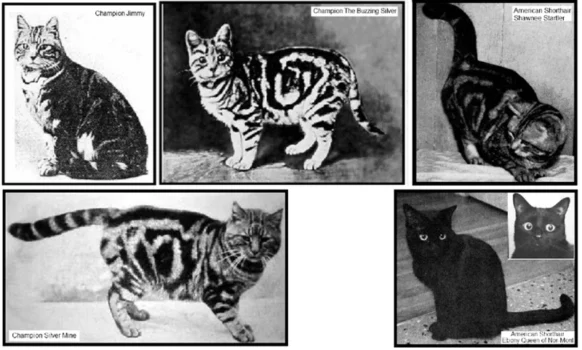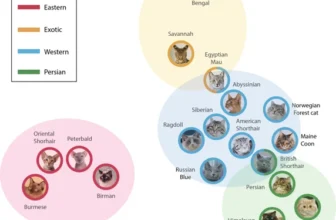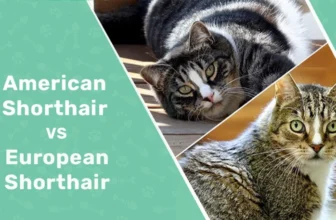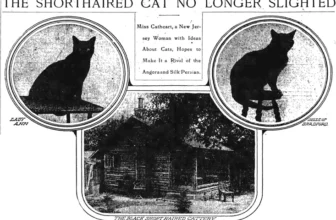Introduction
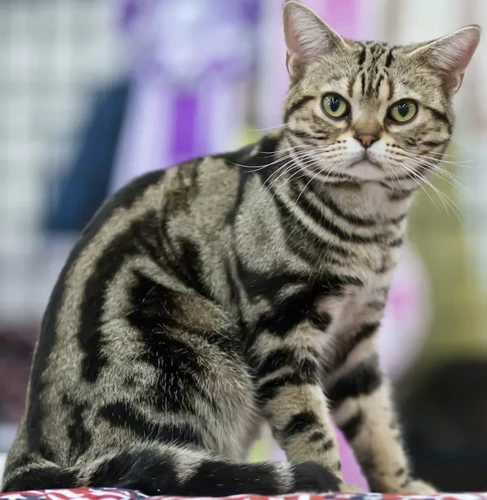
It’s no secret that cats are one of the most beloved and popular pets around the world, with many different breeds existing on every continent. One breed, in particular, has an interesting genetic ancestry and lineage that has contributed to their unique characteristics. We’re talking about the American Shorthair cat, a breed known for their charming personality, adaptability, and health. In this article, we’ll dive into the history, genetics, breeding, and factors that contribute to the characteristics of American Shorthair cats. By the end, you’ll have a comprehensive understanding and appreciation for these beautiful felines. Let’s get started!
Origin and History of American Shorthair Cats
The American Shorthair cat breed is one of the oldest and most iconic breeds in the United States. Their origin can be traced back to the arrival of British shorthair cats in North America during the colonial era in the early 1600s. These British shorthair cats, who were brought over by European settlers, interbred with native American cats. This interbreeding resulted in a cat breed that had a unique set of physical characteristics and traits that helped them survive in the wild.
However, it wasn’t until the 1900s that the American Shorthair cat breed became recognized as a distinct breed. The breeders were working towards standardizing their characteristics to match the expectations of cat shows and competitions.
American Shorthair cats had been used by many early Americans to keep their homes and shops free from rodents and pests. As they served their purpose well, this breed was in high demand for several centuries and found work on farms, ships, and factories.
The American Shorthair cat breed evolution was deeply influenced by the crossbreeding with other European and Asian cat breeds that were already established in the US. The “Exotic Cats” like Persian, Siamese, and Abyssinian had a specifically outstanding effect on American Shorthair cats.
Throughout the years, the breed was systematically refined to attain desirable traits that would make them good house pets, show cats, and ideal companions. By the mid-1900s, the American Shorthair cat had secured its place as one of the most popular cat breeds in the United States.
Today, the American Shorthair cat breed is one of the most beloved household pets, known for their friendly personalities, healthy genes, and adaptability to various living environments.
If we talk about the breed’s qualities, their history and evolution have played an essential role in shaping the breed’s diverse genetic traits and coat colors that it displays today. Different factors like the impact of domestication, genetic diversity, selective breeding, and environmental exposure contribute to the unique look of the breed.
The Genetics of American Shorthair Cats
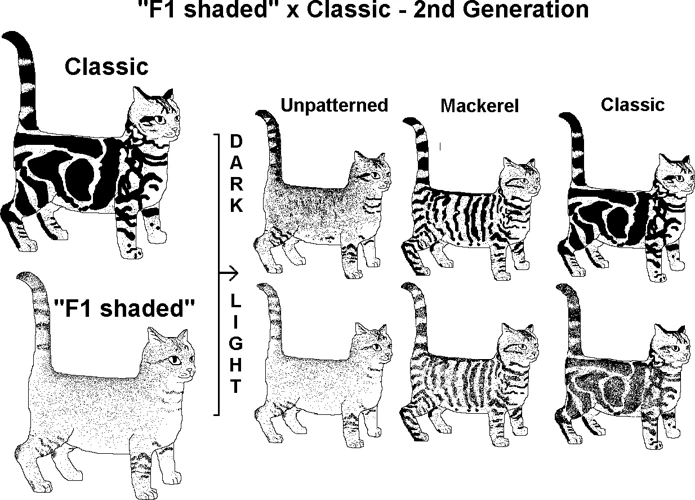
The American Shorthair is a fascinating breed of cat that has been around for centuries. Originally used as a barn cat, the American Shorthair has now become a popular household pet. Understanding the genetics of the American Shorthair can help cat lovers appreciate the unique qualities of this breed. From the inheritance of coat color and patterns to the risk of genetic disorders, this breed’s genetics have contributed to their distinctive features. Let’s explore the DNA behind the American Shorthair. To learn more about the ancesry and evolution of American Shorthair Cats, check out this article.
Inheritance of Coat Color and Patterns
The coat of the American Shorthair cat is an essential aspect of its physical appearance. These cats have a thick, short coat that comes in various colors and patterns. The inheritance of coat color and patterns in American Shorthair cats follows a complex genetic mechanism. Here are the factors that contribute to the inheritance of coat color and patterns in American Shorthair cats:
1. Multiple Genes
Several genes determine the coat color and pattern of American Shorthair cats. The process of inheritance of such a complex trait is still not entirely understood. However, it is known that several genes interact to produce different coat color and pattern variations. Unlike dogs, there is no single gene that determines the coat color and pattern of American Shorthair cats.
2. Dominant and Recessive Genes
The inheritance of coat color in American Shorthairs is due to the presence of dominant and recessive genes. If a cat has two copies of the same dominant gene, it will express that color. On the other hand, a cat must have two copies of a recessive gene to have a coat pattern or color. The sex of the cat also plays a role in the inheritance process.
3. Polygenic Inheritance
Polygenic inheritance refers to inheritance determined by several genes. Polygenic traits do not follow the usual dominant and recessive patterns of inheritance. Instead, the expression of such traits is influenced by several genes. The coat color and pattern of American Shorthair cats follow a polygenic inheritance pattern.
4. Environmental Factors
While genes determine the primary coat color and pattern of American Shorthair cats, some environmental factors also play a role. For instance, the temperature in the womb during the cat’s development can affect the coat’s color and pattern. Additionally, exposure to sunlight can cause changes in the coat’s color.
It’s worth noting that the European Shorthair cats have a significant influence on American Shorthair cats. The breeding of British Shorthair with the European Shorthair in America resulted in the American Shorthair breed that we know today. To know more about the evolution of American Shorthair cats, click on this link.
Disease Risks and Genetic Disorders
One of the advantages of the American Shorthair cats’ breeding history is their relative genetic diversity. However, like any living creature, they are still susceptible to various genetic disorders and diseases.
One of the most common genetic disorders among American Shorthair cats is hypertrophic cardiomyopathy, a condition that affects the heart’s ability to function properly. According to research, this disease is relatively common in domestic cats, including American shorthairs. Genetic testing can help breeders identify cats that might pass on the condition to their offspring and avoid breeding them. It is essential to note that not all cats with the genetic mutation develop the disease, but the risk remains high.
Another genetic disorder that affects American Shorthair cats is Polycystic Kidney Disease (PKD). PKD is a condition where cysts form and grow in the kidneys, potentially leading to kidney failure. The disease is inherited and can be caused by a single gene mutation. Breeding practices can reduce or avoid passing on the disease to offspring.
It’s important to note that some environmental factors might contribute to the development of diseases in American Shorthair cats. For instance, obesity can cause diabetes and arthritis, which are prevalent in older cats. Providing a balanced diet and adequate exercise helps reduce the risk of obesity and its associated diseases.
Breeders and pet owners have a responsibility to ensure the health and well-being of American Shorthair cats. Regular checkups, genetic testing, and a balanced diet enhance the quality of life and longevity of these lovely companions.
Source: /genetic-diversity-american-shorthair-cats/
Breeding and Lineage of American Shorthair Cats
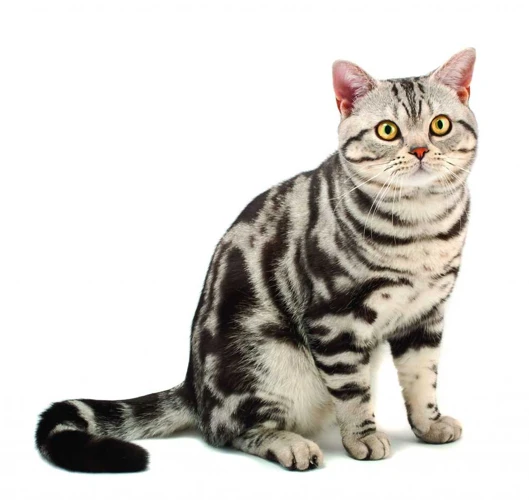
When it comes to American Shorthair cats, their lineage and breeding standards have played a significant role in shaping their genetic makeup and physical characteristics. Understanding the history and purpose of breeding these cats can provide valuable insight into their temperament and health. The traits exhibited by American Shorthair cats today are a result of selective breeding, which is why learning their lineage is crucial. Let’s delve deeper into the world of American Shorthair cat breeding and lineage. To provide context, read up on the general traits and history of the American Shorthair breed here.
Breeding Standards and Cat Shows
Breeding standards and cat shows are crucial elements of American Shorthair genetics. American Shorthair cats have strict breeding standards in order to maintain their distinctive characteristics. These distinctive characteristics include their muscular build, their short, dense coat, and their round faces. Strong American Shorthair cats are poised, alert, and well-balanced. These standards are strictly regulated by the Cat Fanciers’ Association (CFA) and International Cat Association (TICA).
Breeding standards for American Shorthair cats are designed to maintain their lineage and ensure that their offspring exhibit desired traits. These standards dictate which cats can be mated, based on coat color and patterns, eye color, and structural characteristics, such as ear placement and tail length. The mating process is also influenced by kinship, as animals which are too closely related should not be bred with one another. Additionally, the breeding process includes testing for certain genetic diseases, which can lead to serious health issues in offspring.
Cat shows are an essential part of the breeding process for American Shorthair cats. These shows serve as opportunities to display the unique features of American Shorthair cats and compare them to other breeds. Participating in cat shows can help breeders identify valuable cats with desirable traits, and plan future matings that can improve the breed. Famous American Shorthair cats, such as Marsha, have won numerous awards at cat shows, bringing attention to their superior qualities.
In contrast to European Shorthair cats, which are their closest ancestor, American Shorthair cats have distinct breeding standards and a longer history of selective breeding. American Shorthair cats have been present in North America for over 300 years, and over time, they have developed their own unique traits and characteristics. While European Shorthairs continue to influence American Shorthairs, the two breeds have become quite distinct from each other.
Breeding standards and cat shows are essential elements in the preservation of American Shorthair cats and their unique traits. These standards ensure that the breed remains true to its lineage and enables breeders to select cats with desirable qualities. Through this process, American Shorthair cats have evolved into a distinct breed with its own history and characteristics.
Famous American Shorthair Cats
American Shorthair cats have been around for centuries and are now one of the most popular cat breeds in America. Throughout their history, several famous American Shorthair cats have achieved notoriety for their exceptional qualities and unique personalities.
One of the most famous American Shorthair cats is Dewey, also known as the library cat. Dewey lived in Spencer, Iowa, and served as the library cat for the Spencer Public Library for almost 20 years. He was known for his love of books and his friendly personality. Dewey even had a book written about him titled “Dewey: The Small-Town Library Cat Who Touched the World”.
Another famous American Shorthair cat is Stubbs, who served as the honorary mayor of Talkeetna, Alaska, for 20 years. Stubbs was known for his love of people and the attention he received from tourists who came to visit him in his office at Nagley’s General Store, where he spent most of his days lounging in a cat bed.
In addition to Dewey and Stubbs, other famous American Shorthair cats include Maru, who became an internet sensation for his love of boxes, and Grumpy Cat, whose grumpy-faced expression made her a viral sensation.
These famous American Shorthair cats showcase the unique personalities and lovable nature of this breed. While each cat has its own individual traits, American Shorthair cats are known for their intelligence, affectionate personality, and adaptability to different environments.
It’s interesting to note that the evolution of American Shorthair cats has been influenced by other breeds, such as the European Shorthair. Learn more about the influence of European Shorthair cats on American Shorthair cats in our article “EU Shorthair Cats Influence on AM Shorthair Cats“.
Factors Contributing to the Characteristics of American Shorthair Cats
American shorthair cats are known for their distinctive physical features and traits that set them apart from other feline breeds. These traits are a product of various factors that have contributed to their evolution and development. From their diets and nutrition to their genetic mutations and environmental conditions, there are many factors to consider when exploring the characteristics of American shorthairs. In this section, we will delve into the different factors that shape the unique features of these felines. We will also discuss their evolution and compare them to other cat breeds.
Diet and Nutrition
A healthy diet is important for any cat and American Shorthairs are no exception. These cats are known for having a hearty appetite and can be prone to obesity if not fed a healthy, balanced diet. Here are some important considerations for feeding your American Shorthair:
Protein: As obligate carnivores, protein is a vital component of an American Shorthair’s diet. Aim to provide a diet that is high in protein, ideally from animal sources.
Carbohydrates: While some carbohydrates are necessary for energy, these cats do not need very much in their diet. Carbohydrates should make up no more than 10% of their diet.
Fats: Fats are an important source of energy and essential fatty acids for an American Shorthair’s diet. Be sure to avoid diets that are overly high in fat, as this can lead to obesity and other health problems.
Vitamins and minerals: A balanced diet should contain all necessary vitamins and minerals, but it can be difficult to achieve this through diet alone. Consider adding a high-quality vitamin and mineral supplement to your cat’s diet to ensure they are getting all the nutrients they need.
It is crucial to feed your American Shorthair a diet that is tailored to their individual needs, taking into account their age, weight, and activity level. Consult with a veterinarian for recommendations on the best diet for your cat.
American Shorthairs have an evolutionary history of being hardy cats that can survive in a variety of environments, which may contribute to their hearty appetite and ability to tolerate a range of diets. However, feeding your cat a healthy, balanced diet is key for their overall health and well-being.
| Nutrient | Recommended Amount per Day |
|---|---|
| Protein | 20-25g for adult American Shorthair |
| Carbohydrates | No more than 10% of total caloric intake |
| Fats | 5-10g for adult American Shorthair |
| Vitamin A | 200 IU |
| Vitamin D | 20 IU |
| Vitamin E | 2 IU |
| Calcium | 0.8% |
| Phosphorus | 0.6% |
| Magnesium | 0.025% |
Ultimately, being mindful of your American Shorthair’s diet and nutrition needs can help ensure that they lead a happy and healthy life.
Environmental Conditions
The environmental conditions in which American Shorthair cats are raised can have a significant impact on their physical and behavioral characteristics. Let’s examine some of the key factors that can influence these feline friends.
Temperature
Although American Shorthair cats are well-adapted to various climates, they tend to thrive in moderate temperatures. Ideally, room temperatures should be kept between 68-78°F (20-25°C). High temperatures and humidity can lead to heat stress, dehydration, and other health issues.
Lighting
Exposure to natural light is essential for the physical and mental well-being of American Shorthair cats. Sunlight helps the body produce Vitamin D, which helps regulate calcium and phosphorus absorption. Natural light can help regulate the cat’s circadian rhythm, which impacts their sleep-wake cycle and behavior.
Noise
Like most cats, American Shorthair pets have keen hearing and can be easily startled by loud noises. Chronic exposure to excessive noise can cause stress and anxiety, leading to behavioral problems such as aggression or excessive grooming.
Cleanliness
Maintaining a clean living environment is essential for the health and happiness of American Shorthair cats. Regular dusting, vacuuming, and litter box cleaning should be carried out to prevent the accumulation of dust and other irritants that can trigger respiratory problems.
Below is a table summarizing the environmental conditions that are ideal for American Shorthair cats:
| Environmental Conditions for American Shorthair Cats |
|---|
| Temperature: 68-78°F (20-25°C) |
| Exposure to Natural Light |
| Minimal Exposure to Loud Noises |
| Clean Living Environment |
By providing a comfortable, clean, and peaceful environment for American Shorthair cats, you can ensure that they are healthy and happy pets that will be faithful companions for years to come.
Genetic Mutations and Evolution
Genetic mutations have played a crucial role in the evolution of the American Shorthair cats. These mutations occur randomly and can be beneficial, neutral, or negative for the cat’s survival.
Beneficial Mutations
Beneficial mutations can increase the cat’s chances of survival and reproduction, leading to the evolution of new traits. For example, a mutation that improves a cat’s hunting ability can increase its chances of finding food and surviving in the wild. Similarly, a mutation that improves a cat’s immune system can increase its chances of fighting off diseases.
Neutral Mutations
Neutral mutations have neither a positive nor negative effect on the cat’s survival. These mutations can accumulate over time and lead to small differences between populations. For example, a neutral mutation in the fur color of a cat might not affect its ability to survive, but it could contribute to differences in appearance between cats from different regions.
Negative Mutations
Negative mutations can reduce a cat’s chances of survival and reproduction, and can eventually lead to the loss of certain traits or the extinction of a population. For example, a mutation that causes a genetic disorder can reduce the cat’s lifespan and limit its ability to reproduce.
Despite the potential risks, selective breeding can artificially introduce beneficial mutations and eliminate negative ones from a population. Over time, this can lead to a population of cats with desirable traits and fewer genetic disorders.
Genetic mutations have impacted the evolution of American Shorthair cats, both naturally and through selective breeding. While some mutations can be detrimental, others can lead to new traits that allow the cats to thrive in their environment.
Conclusion
In conclusion, American Shorthair cats have a rich history and ancestry that dates back to the early days of American settlements. These cats are known for their attractive appearance, friendly personality, and adaptability to various environments. Understanding the genetic inheritance and lineages of American Shorthair cats can provide valuable insights into their health, behavior, and development.
The genetics of American Shorthair cats play a significant role in determining their coat colors, patterns, and overall appearance. Breeders must follow strict standards to ensure the perpetuation of these desirable traits while reducing the risks of genetic disorders and diseases. Additionally, environmental conditions and diet can also affect the development and health of these cats.
Overall, American Shorthair cats are a delightful addition to any household, and their lineage and ancestry provide an interesting glimpse into their unique characteristics. As with any pet, proper care and attention are necessary to ensure their overall health and well-being. By understanding their genetics and lineage, cat enthusiasts can better appreciate the beauty and distinctiveness of American Shorthair cats.
Frequently Asked Questions
What is the origin and history of American Shorthair Cats?
American Shorthair Cats were originally brought to the United States by European settlers to help control rodent populations on their farms. Over time, they developed into their own distinct breed and were recognized by the Cat Fanciers’ Association in 1906.
What are the inheritance patterns of coat color and patterns in American Shorthair Cats?
Coat color and pattern inheritance in American Shorthair Cats is a complex process, involving multiple genes and possible interactions between them. Different coat colors and patterns can be passed down from parents to offspring, resulting in a wide range of coat variations.
What are some common genetic disorders in American Shorthair Cats?
Some common genetic disorders in American Shorthair Cats include polycystic kidney disease, hypertrophic cardiomyopathy, and progressive retinal atrophy. It is important for breeders to screen their cats for these disorders and only breed those that are genetically healthy.
What are the breeding standards and expectations for American Shorthair Cats at cat shows?
At cat shows, American Shorthair Cats are judged based on a set of criteria, including coat color and pattern, body type, head shape, eye color, and overall appearance. Breeders strive to produce cats that meet these standards and are competitive in the show ring.
Who are some famous American Shorthair Cats?
Socks, the cat of former U.S. President Bill Clinton, and Tom, the cartoon character from the Tom and Jerry series, are both famous American Shorthair Cats.
What role does diet and nutrition play in the health of American Shorthair Cats?
Diet and nutrition play a critical role in the health of American Shorthair Cats. A balanced diet that meets their nutritional needs can help prevent a variety of health problems, including obesity, diabetes, and dental issues.
How do environmental conditions affect the behavior and health of American Shorthair Cats?
Environmental conditions, such as exposure to toxins, temperature extremes, and stress, can have a significant impact on the behavior and health of American Shorthair Cats. It is important to provide a safe and comfortable living environment for them.
How have genetic mutations and evolution influenced the characteristics of American Shorthair Cats?
Genetic mutations and evolution have played a role in shaping the characteristics of American Shorthair Cats, including their coat color and pattern, body type, and temperament. Over time, selective breeding and natural selection have led to the variety of traits we see in the breed today.
What are some common behavioral traits of American Shorthair Cats?
American Shorthair Cats are known for their friendly and adaptable personalities. They are typically good with children and other pets, and enjoy being around their human family members. They also have a natural hunting instinct and enjoy playing and exploring their environment.
What is the lifespan of an American Shorthair Cat?
An American Shorthair Cat can live for 12-16 years or more with proper care and nutrition. Regular veterinary care and attention to their health needs can help ensure a long and healthy life for your feline friend.

